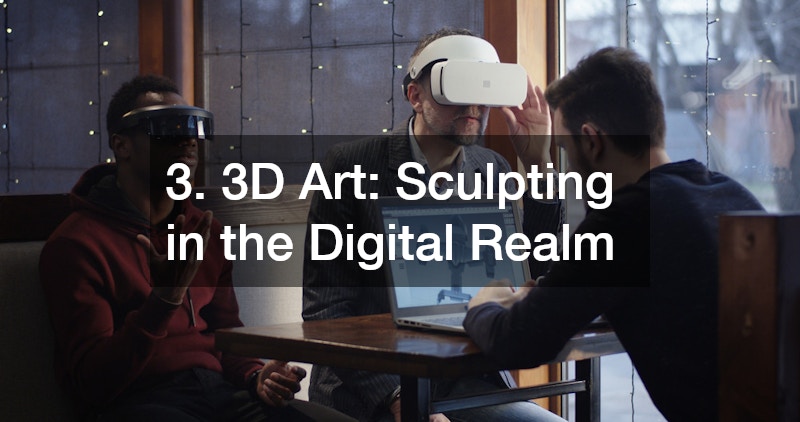Digital art has evolved into a versatile and widely accepted form of artistic expression. With advances in technology, artists now have more tools and creative outlets than ever before. If you’re an artist or art enthusiast looking to explore the digital art world, understanding the different types of digital art is essential.
In this article, we’ll walk you through seven prominent types of digital art that you should know about in 2025, showcasing how technology is reshaping creativity in the art world.
1. Digital Painting: The Classic of Digital Art
Digital painting is one of the most popular and classic forms of digital art. It mimics traditional painting techniques but with the power of digital tools. Using a tablet, stylus, and software like Adobe Photoshop or Corel Painter, artists can create artwork that appears to be painted by hand, but with the flexibility and convenience of digital media.
Why is Digital Painting Popular?
- Freedom and Flexibility: Artists can easily undo mistakes, experiment with colors, and use a variety of brushes without worrying about the limitations of traditional media.
- Versatility: Digital painting can be used to create everything from portraits to landscapes, fantasy art, and even abstract pieces.
Is digital art real art? Many argue that digital painting holds the same artistic value as traditional painting. The creativity, skill, and time invested in crafting a digital painting are no less than those of a traditional piece.
2. Pixel Art: Retro Meets Modern Technology
Pixel art uses pixels to create images. It’s often associated with early video games and has made a comeback in recent years, appealing to both nostalgia and contemporary art movements.
Why Pixel Art is Popular in 2025:
- Low-Fi Aesthetic: Pixel art’s intentionally blocky, low-resolution design is both charming and visually striking, making it a favorite among game designers, app creators, and digital illustrators.
- Unique Charm: The simplicity and precision required in pixel art make it visually distinct from other digital art forms.
Many modern artists are using pixel art in everything from indie video games to digital posters, proving its lasting appeal.
3. 3D Art: Sculpting in the Digital Realm

3D digital art has taken the world by storm, especially in industries like gaming, film, and virtual reality. Using programs such as Blender or Autodesk Maya, 3D artists can create three-dimensional models that can be animated or rendered into lifelike images.
Why 3D Art is Changing the Game:
- Realistic Rendering: 3D artists can create detailed, lifelike characters and environments that look as realistic as traditional sculptures.
- Immersive Experiences: 3D art is integral in virtual reality (VR) and augmented reality (AR) experiences, providing users with fully immersive digital worlds.
Whether it’s for movies, games, or virtual exhibits, 3D art continues to shape digital creativity.
4. Generative Art: Letting Algorithms Create Art
Generative art uses algorithms and computer code to create art. Artists design the rules or parameters, and then the computer generates artwork based on those rules. It’s a fascinating intersection of technology and art, allowing for infinite possibilities.
Why Generative Art is on the Rise:
- Endless Variations: The use of algorithms means that the same set of parameters can create thousands of unique variations, making it a perfect form for digital artists who want to explore randomness and complexity.
- Tech Meets Creativity: Generative art showcases the synergy between creativity and technology, making it a popular choice among digital artists pushing the boundaries of what’s possible.
Generative art allows artists to combine their skills with the power of algorithms to produce something truly innovative.
5. 3D Animation: Breathing Life into Digital Creations
3D animation involves the process of creating three-dimensional moving images using digital technology. It’s widely used in film, advertising, and entertainment. Artists use software like Blender or Cinema 4D to create animations that can range from highly stylized to photorealistic.
Why 3D Animation is Essential:
- High Demand: As the entertainment industry increasingly relies on digital creations, 3D animation has become an essential skill for artists interested in film and video game production.
- Visual Storytelling: 3D animation allows artists to tell compelling stories through visuals, making it a staple in everything from animated films to educational videos.
The potential for creativity in 3D animation is limitless, offering artists the opportunity to create stunning narratives and lifelike visuals.
6. Digital Collage: Combining the Old and the New

Digital collage is a form of digital art that involves combining various images, textures, and elements to create a single, cohesive piece. Artists often blend photos, illustrations, textures, and other digital assets to create something entirely new.
Why Digital Collage is Trending:
- Fusion of Media: Digital collages blend old-school collage techniques with modern digital tools, allowing artists to explore new creative possibilities.
- Expressive and Personalized: Digital collage offers endless opportunities for self-expression and experimentation, whether through surrealism, pop art, or abstract work.
For artists who love playing with contrast and blending various elements, digital collage is a versatile and expressive form of art.
7. NFT Art: The Intersection of Art and Blockchain
Non-Fungible Tokens (NFTs) have revolutionized the world of digital art by allowing artists to sell their digital creations as unique, blockchain-backed assets. NFT art has exploded in popularity, with digital artists selling one-of-a-kind pieces for millions of dollars.
Why NFT Art is Here to Stay:
- Ownership and Authentication: With NFTs, you get a sense of ownership and authenticity that was difficult to achieve in the past.
- New Revenue Streams: NFT art opens up new opportunities for artists to monetize their work, creating a direct link between creators and buyers without relying on galleries or intermediaries.
NFTs offer a way for digital artists to thrive financially while showcasing their creativity on the global stage.
Conclusion: Embrace the Future of Digital Art
As technology continues to advance, digital art will only become more diverse and influential in the art world. Whether you’re a traditional artist venturing into digital media or a digital native exploring new forms, the possibilities are endless. By understanding the 7 types of digital art highlighted above, you can explore and experiment with these exciting creative avenues in 2025.
Each type of digital art offers its own unique possibilities, and with the right tools and techniques, you can craft your own artistic vision. So, don’t wait—dive into the world of digital art and explore all the exciting opportunities waiting for you.


